Hypselodoris bullocki
Page 2
See Page 1, Page 3.
See Hypselodoris apolegma, which may be a colour form.
Rudman, W.B., 2000 (March 14) Hypselodoris bullocki Page 2. [In] Sea Slug Forum. Australian Museum, Sydney. Available from http://www.seaslugforum.net/find/hypsbull2
Related messages
Hypselodoris bullocki - eggs
March 30, 2001
From: Michael Miller
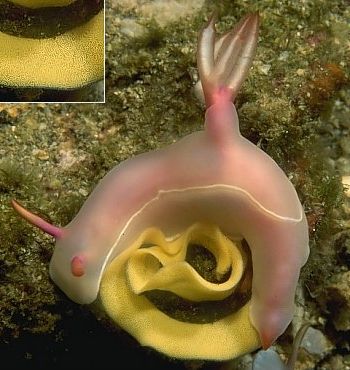
Dear Bill
Following on Drew's message from Western Australia, attached is a pic of a Hypselodoris bullocki with the color form said to be characteristic of the original description. The egg mass color correlates with earlier postings of other H. bullocki color variations with the same yellow egg mass, the similarity of which you have already commented on.
Location: Batangas, Philippines
Dive spot: Twin Rocks
Depth: 45 ft.
Photographer: Michael D. Miller
Cheers,
Michael Miller
mdmiller@cts.com
Miller, M.D., 2001 (Mar 30) Hypselodoris bullocki - eggs. [Message in] Sea Slug Forum. Australian Museum, Sydney. Available from http://www.seaslugforum.net/find/4063Thanks Michael,
The size of the eggs (see inset) would suggest that this species has planktonic larvae.
Bill Rudman.
Note added March 31, 2001: Yoshi Hirano has just alerted Mike and I that the egg ribbon image was reversed. It is now the right way around. The animal is of course photographed from the left side so the genital opening, from which the egg ribbon is being extruded, is not visible. ...... Bill Rudman.
Rudman, W.B., 2001 (Mar 30). Comment on Hypselodoris bullocki - eggs by Michael Miller. [Message in] Sea Slug Forum. Australian Museum, Sydney. Available from http://www.seaslugforum.net/find/4063Hypselodoris bullocki mating - W. Australia
March 28, 2001
From: Drew Taylor
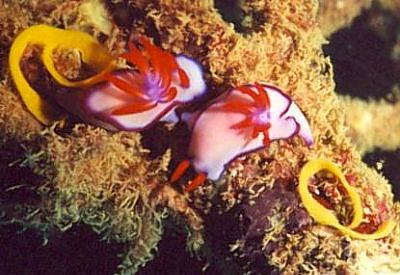
Dear Bill,
At the same time I found Chromodoris coi laying eggs [22 March 2001, Navy Pier, Exmouth, North West Cape, Western Australia, 11 metres of water], I also observed this pair of Hypselodoris bullocki mating beside two sets of egg ribbons. The following day I again dove the Pier and found one of the Hypselodoris bullocki still in the same spot laying another ribbon.
Regards
Drew Taylor
orcaunderwater@nwc.net.au
Taylor, D., 2001 (Mar 28) Hypselodoris bullocki mating - W. Australia. [Message in] Sea Slug Forum. Australian Museum, Sydney. Available from http://www.seaslugforum.net/find/4043Thanks Drew,
These animals are the same colour pattern as in your earlier message, supporting my feeling that this is a northwestern Australian colour form - though photos proving me wrong are very welcome. The egg ribbon photos are also very interesting. I have been asking for egg ribbon photos in the hope that there might be some obvious differences in colour or shape to correlate with body colour. However looking through the Forum messages I think 3 colour forms have this yellow coloured egg mass. Which only goes to prove that there is seldom a simple answer.
Best wishes and many thanks,
Bill Rudman
Hypselodoris bullocki - the blue dorid
March 21, 2001
From: Kristin English Porter
I am a herpetologist. I am a keeper in a zoo and recently I have been thrust head on into the world of salt water ecosystems at work. My parents saw my excitement at the challenge and suprised me with a 55 gallon salt water aquarium. It is a reef system with safely cultured live rock (not blasted off a reef!). It is now about 6 months young. A week ago my mother stopped off and brought a suprise. A blue dorid nudibranch she found at the local fish shope. The store owner told her that it eats algae and microorganisms off of the live rock. I spoke with my zoo friends and they said that they ate gorgonia. What do i need to supply my new charge with a happy healthy life? It has already laid an egg ribbon! But I was told if the fish have not eaten it yet, they will eventually. Any information about life span, environment preferences, and diet would be greatly appreciated. I did not know what a challenge he would be until I began research!
Kristin
turtle-6@msn.com
Porter, K.E., 2001 (Mar 21) Hypselodoris bullocki - the blue dorid. [Message in] Sea Slug Forum. Australian Museum, Sydney. Available from http://www.seaslugforum.net/find/4002Dear Kristin,
If you have a look through the other messages on the Hypselodoris bullocki pages you will see that others have asked the same question and I am afraid the answer is not very palatable. Firstly aquarium shop owners who are telling their customers that nudibranchs are grazing herbivores are either lying or just don't know. In either case I think they are irresponsible and not exercising their duty of care to their customers, or for that matter to the animals in their care. Imagine the outcry if they started selling puppies and kittens and advised their customers that they just eat cheap bird seed!
Every species of nudibranch has a very specialised diet. No generic 'nudibranch food' exists. In the case of Hypselodoris bullocki we are not even sure which species of sponge it feeds on, but it is basically a specialised sponge feeder and will eat a sponge found in its Indo-West Pacific Ocean home. I am sure the aquarium dealer does not have the sponge in stock, and like most sponges, even if you could identify its food, it would be very difficult to keep alive in a home aquarium. Sorry I can't give you better news, but as I have said to others before I think you should let the aquarium shopkeeper know that keeping and selling nudibranchs, or any animals for that matter, which he has no knowledge of and no ability to keep them alive is unacceptable.
Best wishes,
Bill Rudman
Hypselodoris bullocki Egg Ring
January 24, 2001
From: Cindy Luczkow
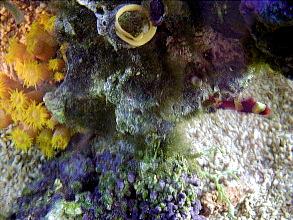
Hi, I just purchased a Hypselodoris bullocki at a Fish Store in Southern Oregon, not realising how difficult it is to sustain. I do have some sponges in my 72 gallon reef tank but whether they are of the right species, I don't know.
Upon introducing it into my tank, It formed a yellow ringed egg sack ontop of an astro snail.
What do I do next? I hate to be the cause of these little guys dying.
Help!!
Cindy L.
artizt@internetcds.com
Luczkow, C., 2001 (Jan 24) Hypselodoris bullocki Egg Ring. [Message in] Sea Slug Forum. Australian Museum, Sydney. Available from http://www.seaslugforum.net/find/3592Dear Cindy,
You are not the cause of them dying. Blame that on the people who organised to ship them to the USA then conned shop owners into stocking them and customers into buying them.
There is a slight chance that you have a sponge in your tank that Hypselodoris will feed on. I don't think there is much point taking it back to the shop because they won't be able to feed it either - although it might teach then that they shouldn't be stocking them. As to the eggs. The eggs will hatch as little veliger larvae that will swim in the water looking for planktonic algae to eat. If they escape your filters, and find the right algae to eat they might survive, but unless you have the right sponge, there is little chance they will take the next step and metamorphose into a baby slug.
Sorry I haven't better news for you
Best wishes,
Bill Rudman
Hypselodoris bullocki - feeding and care.
December 31, 2000
From: Edward Sipolt
I am a 3 year experienced reefkeeper, recently I made a move to include three H. bullocki (purple/white/yellow coloration) into my prized fishtank. They have now survived for three months on a combination of Breadcrumb Sponges, Aiptasia anemones, and the occasional sponge that happens in on the liverock I purchase. Or so it seemed. My H. bullocki appear to feed off these other food sources sparingly, and have taken the bulk of their nutrition from a few large patches of what appeared to be algae, but is now identified as Aplysilla glacialis.
Information on this particular sponge can be found at
http://www.biology.ucsc.edu/classes/bio161l/Images/Animals/a01apl.html
Edward Sipolt
runic@msn.com
Sipolt, E., 2000 (Dec 31) Hypselodoris bullocki - feeding and care.. [Message in] Sea Slug Forum. Australian Museum, Sydney. Available from http://www.seaslugforum.net/find/3320Dear Edward,
Thanks for the interesting information. When I began reading your message I found it difficult to believe they would eat breadcrumb sponges or sea anemones but Aplysilla glacialis makes much more sense. From memory I think A. glacialis is endemic to the west coast of North America, so can I assume you are adding this to your aquarium?
Interestingly, Aplysilla glacialis has been reported often as the food of a number of Nth America West Coast species of Cadlina,a genus closely related to Hypselodoris. Although nudibranchs are very specific feeders, there is always a possibility that a closely related sponge from some other part of the world will be acceptable to them. That is why I have suggested in the past that people look for local sponges related to Aplysilla, which is a genus of sponges often eaten by chromodorids, and test them on their captive chromodorids.
Good luck with your H. bullocki
Best wishes,
Bill Rudman.
The 'Exmouth Chromodoris'
September 29, 2000
From: Drew Taylor
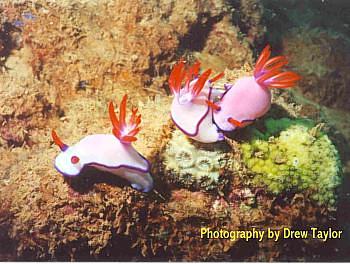
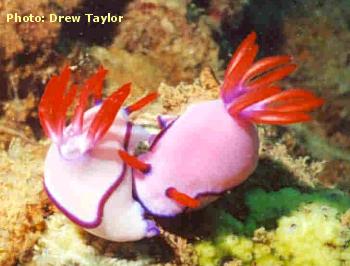
Bill,
These three Nudibranchs I photographed at Bundegi Reef in Exmouth [Northwestern Australia] in November 1999. The reef was damaged severly after Cyclone Vance but it is great to see that the Nudibranchs manage to live on. I have identified them as being in the Family Chromodorididae with the common name being "Exmouth Chromodoris" (Nudibranchs of the South Pacific). Can you please confirm this for me?
During this dive my buddy and I observed these Nudibranchs to be mating and the third one in the picture had its reproductive pore exposed and was attempting to get in on the fun.
P.S. I love your site, and I will be spending hours on it.
Drew Taylor
orcaunderwater@nwc.net.au
Taylor, D., 2000 (Sep 29) The 'Exmouth Chromodoris'. [Message in] Sea Slug Forum. Australian Museum, Sydney. Available from http://www.seaslugforum.net/find/3072Dear Drew,
This is one of a group of animals which I am calling at present Hypselodoris bullocki. This colour form is quite common in northwestern Australia from Darwin around to Exmouth. If you look at the other messages about Hypselodoris bullocki you will see plenty of photos showing the various colour variations. I have included a close-up photo of the mating pair.
Neville Coleman has indeed called this the 'Exmouth Chromodoris' but I personally don't like authors making up 'common' names for animals. Firstly they are not names in 'common use' and often different authors will make up their own 'common names' which is very confusing for interested amateurs. A perfect example is found with fish. The fishing industry and fish scientists have spent many years and much effort in trying to prepare a standard list of common names to be used in Australia. Often the same common name has ben used in different parts of Australia for different fish. Ironically if they had just used the scientific names there would have been no confusion and everyone on the world would know what they mean. I think most amateur naturalists are quite capable of using scientific names. After all gardeners do it all the time when discussing plants. This is a rather long-winded way of saying that 'Exmouth Chromodoris' is a bit unfortunate because the species is a Hypselodoris not a member of the genus Chromodoris. If you are going to use a scientific genus name as part of the common name why not just use the scientific name?
Thanks for the beautiful photo, and another record of this colour form.
Best wishes,
Bill Rudman.
Keeping Hypselodoris bullocki in an aquarium
September 28, 2000
From: Patrick Champeyrol
My favorite petshop has recently received a few Hypselodoris bullocki. It's a very beautiful slug. Do know you if they accept other sponges for eating or if they die of starvation? I have read you give to them 'Angel Formula' from 'Ocean Nutrition' and my question is do they eat it?
Thanks!
Patrick Champeyrol
pacha1@club-internet.fr
Champeyrol, P., 2000 (Sep 28) Keeping Hypselodoris bullocki in an aquarium. [Message in] Sea Slug Forum. Australian Museum, Sydney. Available from http://www.seaslugforum.net/find/3074Dear Patrick,
If you look through the other messages on this page and on Page 1, you will see others have asked the same question. I don't know of anyone having success with an artificial food. Chromodorid nudibranchs eat sponges by rasping off bits of sponge with their radula. I would think that any artificial food would need to be in a solid block so that the slugs could imitate their normal feeding action. I don't know what 'Angel Formula' is but if it a powder or flakes I can't see how the slug could eat it.
It would certainly be interesting to find some artificial food that actually worked, but my only fear would be that if such a food was found then no nudibranch would be safe from the activities of commercial collectors.
Best wishes,
Bill Rudman.
Hypselodoris bullocki from Queensland
August 23, 2000
From: Stuart Hutchison
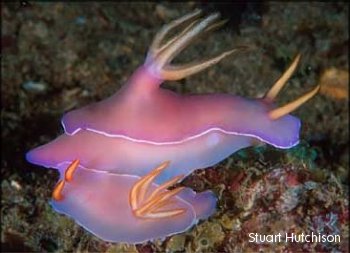
Dear Bill,
Here is a pair of Hypselodoris bullocki from the SS Yongalla (near Townsville - Queensland, Australia) in March 2000.
Depth 30m,
sizes 35mm and 20mm.
Regards,
Stuart
hutchco@tpg.com.au
Hutchison, S., 2000 (Aug 23) Hypselodoris bullocki from Queensland. [Message in] Sea Slug Forum. Australian Museum, Sydney. Available from http://www.seaslugforum.net/find/2878Thanks Stuart,
Bill Rudman.
Information on Hypselodoris bullocki
August 18, 2000
From: Santos Al Halper
I am A very enthusiastic reef keeper and I am very interested in The Bullocki Species (I have always thought it was Chromodoris but I guess that I was wrong about that) anyhow I am interested as to if anyone knows any particular species of sponge this nudibranch eats. I am very interested in keeping this species and would appreciate any info into this problem. :-)
Santos
Santos_al_halper@excite.com
Al Halper, S., 2000 (Aug 18) Information on Hypselodoris bullocki. [Message in] Sea Slug Forum. Australian Museum, Sydney. Available from http://www.seaslugforum.net/find/2885Dear Santos,
Many popular books put this species in the genus Chromodoris. One advantage of the Forum is that it can you up to date with what the 'experts' are thinking about such things. One thing I am sure after looking at its anatomy is that it not a Chromodoris. It has features of both Hypselodoris and Risbecia and at present Hypselodoris seems the best place to put it, until a more extensive review can be done on it in all its colour forms.
As to what it feeds on, have a look at all the messages in the Forum on H. bullocki. It has been discussed at some length. There are no easy answer but at least you will get a feel for the problems. To find the messages, some a below your message on this page and some are on H. bullocki Page 1. another way to find stuff on H. bullocki is to use the SEARCH button at the top of each page, or in the yellow band at the top of each message.
Best wishes,
Bill Rudman.
Hypselodoris bullocki? from NW Australia
July 24, 2000
From: Matthew Archer
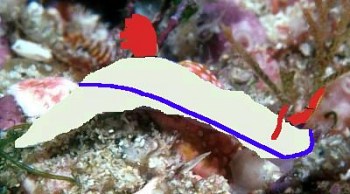
Dear Bill
I found several of these nudibranchs on a recent diving trip to the Ningaloo Reef. They were found between 2/7/00 and 14/7/00 on coral bombies, in about 15-20 meters depth. The water temp was 23 degree. The nudibranchs were only quite small- usually between 3-4 cm. I've been looking through the species list but can't really make a definate ID. Could it be a variant of Hypselodoris bullocki?
Sorry, I don't have a camera, so this reconstructed drawing was the best I could do. I hope you get the general idea (pale/white with a dark blue margin and dark red gills/rhinopores- there were no other markings).
Yours Sincerely,
Matthew Archer
mattarch99@hotmail.com
Archer, M., 2000 (Jul 24) Hypselodoris bullocki? from NW Australia. [Message in] Sea Slug Forum. Australian Museum, Sydney. Available from http://www.seaslugforum.net/find/2757Dear Matthew,
Congratulations on the reconstruction. I would suspect it is part of the Hypselodoris bullocki complex. I am hesitant to say they are all varieties of one species, but must admit to difficulties in finding any anatomical differences. I have not actually seen a 'form' with a blue border, but I do illustrate one from Darwin (Photo D. on the Hypselodoris bullocki page) which has a bluish-purple border.
Best wishes,
Bill Rudman.
Another hungry Hypselodoris bullocki
May 1, 2000
From: Richard Camp
HI,
I just recently bought a nudibranch from a distributor and i have know idea what to feed it can you suggest species of coral or types of food i can feed it?
thank you,
Richard
Carnnisaur@aol.com
Camp, R., 2000 (May 1) Another hungry Hypselodoris bullocki. [Message in] Sea Slug Forum. Australian Museum, Sydney. Available from http://www.seaslugforum.net/find/2337Dear Richard,
Since you put Hypselodoris bullocki in the title can I assume that is what you have? Have a look at the photos on the Hypselodoris bullocki Pages to make sure.
If you do have H. bullocki, have a look at the two messages from Laura Romin [message 1, message 2] where we discuss its food and she suggests an artificial substitute. I haven't heard back from her to see if it was a success but it's worth a try or perhaps you could email her.
Have a look at the page and messages about Keeping slugs in captivity.
Best wishes,
Bill Rudman.
Blue Hypselodoris cf bullocki
April 17, 2000
From: Ken Sullivan
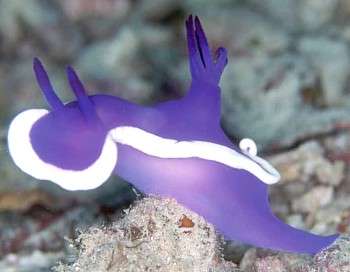
Hi Bill,
I am another of those mad underwater photographers who have a liking for sea slugs and butterfly fish. I was recently talking to Lindsay from Operation Wallacea and mentioned that I had a slide of a Hypselodoris bullockii (colour variation) taken under the 'Rig' in Mabul Malaysia. She said you might be interested in seeing a scan which I have attached.
Try our web site http://www.pops.co.uk
Best regards
Ken
sully@cwcom.net
Sullivan, K., 2000 (Apr 17) Blue Hypselodoris cf bullocki. [Message in] Sea Slug Forum. Australian Museum, Sydney. Available from http://www.seaslugforum.net/find/2274Dear Ken,
I am indeed interested in your scan of this blue animal. More records of particular colour patterns are useful in getting an idea of how constant certain colour forms/ species are.
Other photos of other nudibranchs would be equally welcome.
Best wishes,
Bill Rudman.
Hypselodoris bullocki from the Marshall Ids
March 16, 2000
From: Scott Johnson
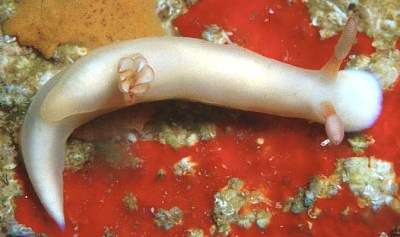
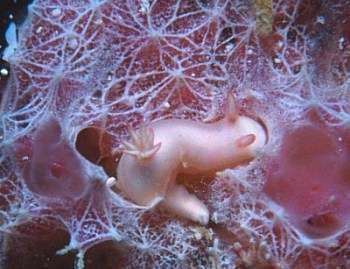
Hi Bill,
Enjoyed seeing the selection of color forms of Hypselodoris bullocki on the Forum. If they are indeed all one species, it certainly is a variable one!
Do you know if the color forms overlap geographically? I have personal experience with only two color forms, the attached from the Marshalls Islands and a second group from the Solomon Islands. Although uncommon in the Marshalls, all specimens are pale pink to white. Occasionally large specimens such as
E143-1 (UPPER RIGHT)(about 30mm) have an edging of purple around the anterior margin and on the tip of the tail. Primary food source seems to be the pink sponge that E143-3 (LOWER RIGHT) is nestled into, possibly what gives the nudibranch its pink coloration.
In the Solomons, [see separate message] the species is much more common and often larger than the largest from the Marshalls.
Scott
johnson@kmr.ll.mit.edu
Johnson, S., 2000 (Mar 16) Hypselodoris bullocki from the Marshall Ids. [Message in] Sea Slug Forum. Australian Museum, Sydney. Available from http://www.seaslugforum.net/find/2091Dear Scott,
Concerning regional colour forms, the pink form with a pale or white border is the common Great Barrier Reef form and around the North West coast of Australia there seems to be a purple-edged form but more information from others would certainly be interesting.
Best wishes,
Bill Rudman.
Hypselodoris bullocki from the Solomon Ids
March 16, 2000
From: Scott Johnson
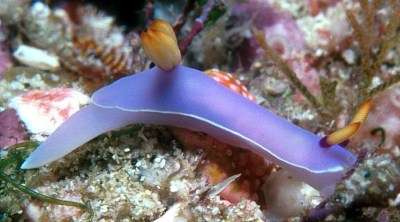
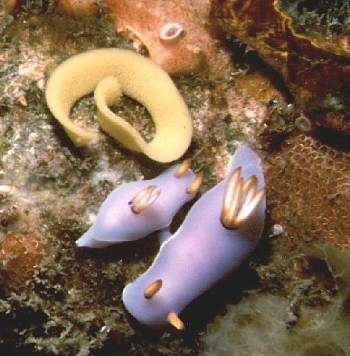
Hi Bill,
Following on my message on Hypselodoris bullocki from the Marshall Islands here are some observations from the Solomon Islands. In the Solomons, the species is much more common and often larger than the largest from the Marshalls. All those I saw in the Solomons were of the form shown here. The lower photo shows a copulating pair next to what I assumed was their egg mass, although I did not actually see it being deposited.
Scott.
johnson@kmr.ll.mit.edu
Johnson, S., 2000 (Mar 16) Hypselodoris bullocki from the Solomon Ids. [Message in] Sea Slug Forum. Australian Museum, Sydney. Available from http://www.seaslugforum.net/find/2092